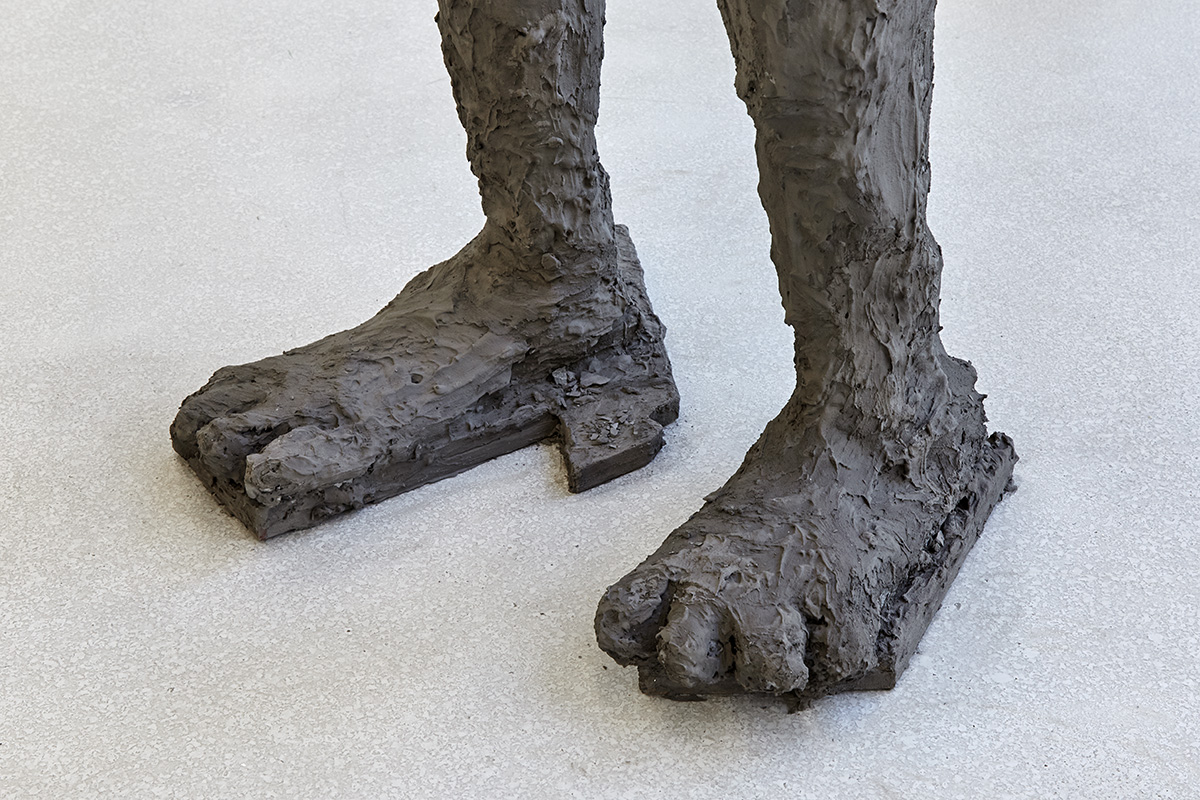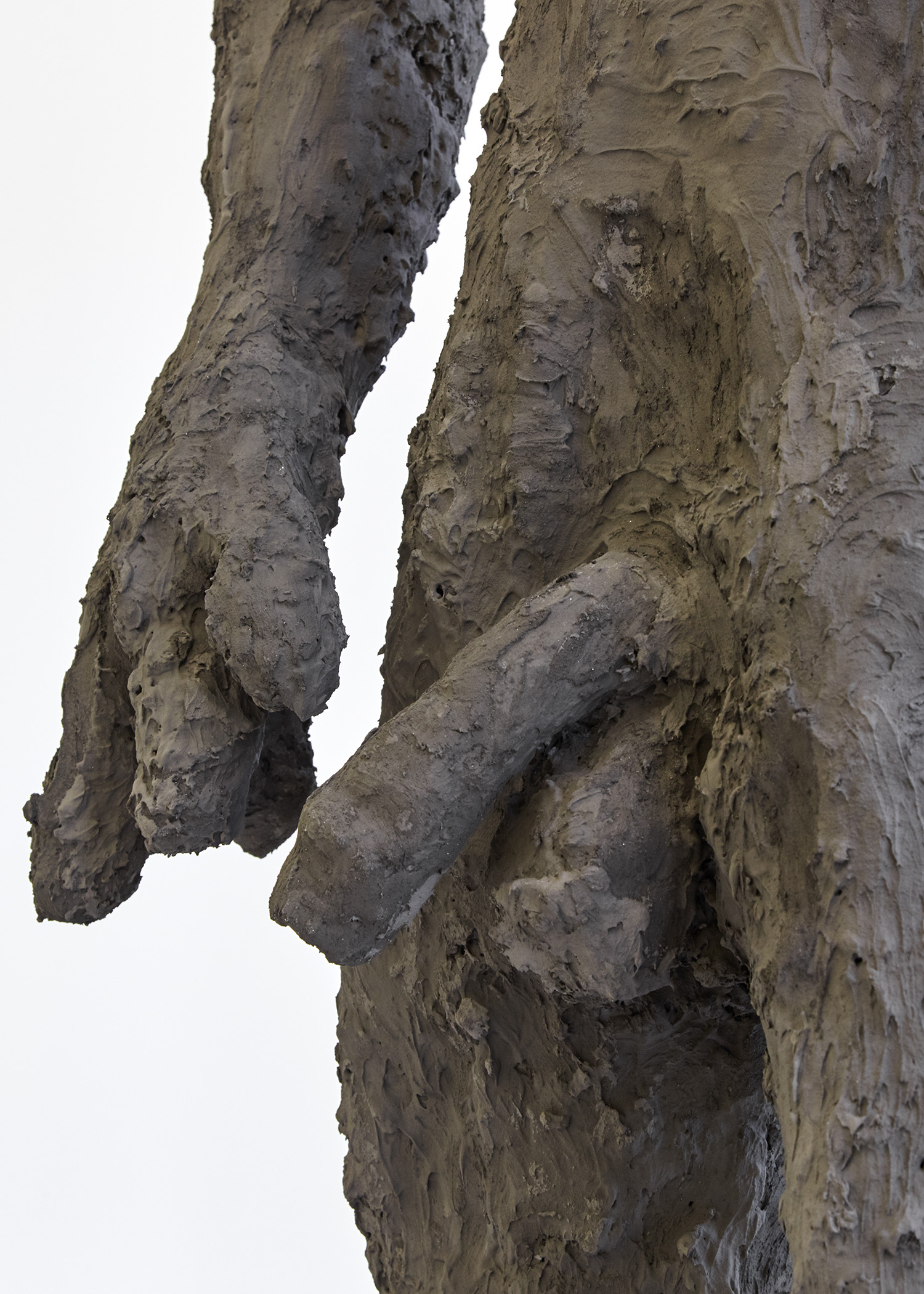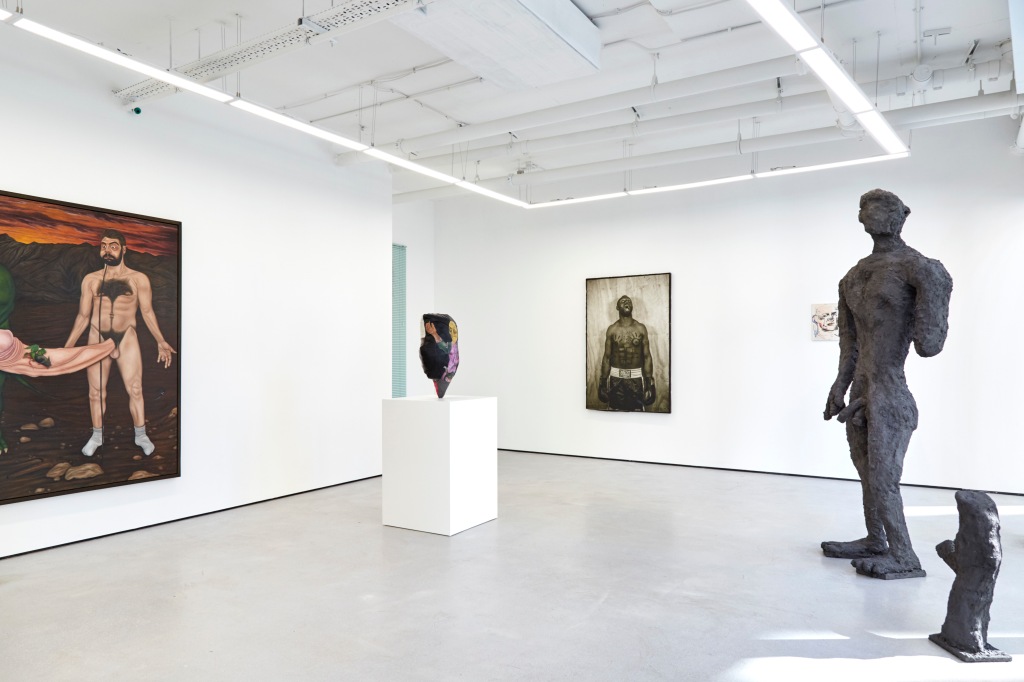
Installation shot. Courtesy of the artists and Lychee One. Photo: Corey Bartle Sanderson.
The exhibition ‘Young Monsters ‘, on show at Lychee One until 26 October 2019, has been curated by London-based American independent curator Marcelle Joseph as a way of exploring the multifariousness of masculinity today by representing “often-unspoken vulnerabilities, idiosyncrasies and intersectional hybridities” (to quote one of the main inspirations for the show, curator and horror writer Charlie Fox).
Below my conversation with Joseph about the exhibition:
Francesco Ferranti: Good morning Marcelle, can you first of all introduce yourself and discuss your approach to curating [in particular referring to your work with non-binary and female-identifying artists]?
Marcelle Joseph: My curatorial mission is to support, bring attention to and bestow agency upon artists that have been marginalised by the patriarchal canon of art history and the largely white male-dominated art world, so I am often working with female-identifying and non-binary artists. As Oprah Winfrey said, ‘There is no discrimination against excellence’. As a curator and a collector, I am attempting to support excellence that may not be recognised institutionally or commercially as the art market is largely led by men for men whether they be male museum directors, gallerists, artists or collectors. A recent joint study by Artnet News and In Other Words published in September 2019 proves this point. Just 11% of all acquisitions and 14% of exhibitions at 26 prominent American museums over the past decade were of work by female artists. And the most recent Freelands Foundation report on the representation of female artists in Britain during 2018 found that only 32% of the artists represented at top London commercial galleries were women, despite the fact that 65% of the postgraduates studying art in the UK were women. In line with my mission, in January 2020, I will curate a group exhibition featuring the work of ten female-identifying artists and inspired by the feminist science fiction writings of Ursula Le Guin.
Francesco Ferranti: “Monsters cause trouble, they disturb definitions, they discombobulate what we think we mean. All of which is brave and wild, not to mention something like art’s task”. This quote from Charlie Fox, writer of ‘This Young Monster’ and curator of the exhibition ‘My Head is a Haunted House’, encapsulates the spirit of ‘Young Monsters’. Can you take us on a curatorial journey behind the show?
Marcelle Joseph: I have taken Charlie Fox’s quote in epigraph for this exhibition titled ‘Young Monsters’ in order to explore the multiplicity of masculinities displayed in the presented artworks by four male-identifying artists with identities that span across gender and racial spectrums. Whether straight, gay, trans, black, white, working class or middle class, the attributes of masculinity exhibited by male-presenting humans need not be toxic, and this is supported by research by the likes of feminist physicist Karen Barad who postulates in her agential realism theory (2007) that humans are not individually determinate with a fixed or given set of differences, but only materialise into individuals in “intra-actions” or relations with each other and the environment. Therefore, gender needs no longer to be understood as an inherent attribute of the individual subject. In fact, the idea of a singular, fixed masculinity was rejected back in the late 1980s by a new sociology of masculinity led by sociologist Raewyn Connell who described a myriad of masculinities moulded by class, race, culture, sexuality and other factors, often battling against each other for authenticity. For Barad and Connell, there is no sense of fixity in terms of understanding masculinity and what human or species can exhibit these behavioural attributes that can vary dramatically across time and place. The same is true of the artists in this exhibition.
Francesco Ferranti: “Queering” the gaze is a central concern of mine as an independent curator and art writer. I think you have done a brilliant job in exploring the nuanced and blurred facets of contemporary masculinities. What strategies do you think are the most effective and long-lasting with regard to curating similar shows? Queer artists are still underrepresented in permanent collections in the UK. What do you think are the reasons for this institutional erasure?
Marcelle Joseph: We are all humans regardless of gender or race so let’s support the representation and agency of all humans. I happen to be a curator so I can choose curatorial constructs and thematics that reinforce and bolster this fact. I hope that museum acquisition committees will begin to acquire artworks by artists that represent the rich diversity of the populace.
Francesco Ferranti: Neil Haas’s blind work Draco Malfoy-23 Years (2019) explores the artist’s role in the world as a queer person with a strong religious faith, while monumental wood, steel and jesmonite piece Young Man Bathing (2019) reminds me of the ephebic statues of kouroi (Greek youth, “ancient twinks”) hinting at ideas of fragility and sensuality. How do you read Haas’ approach to embodying masculine energy through sculptural figures?
Neil Haas, ‘Young Man Bathing’, 2019, wood, steel & jesmonite, 218 x 86 x 48cm & 66.5 x 38 x 25. Courtesy of the artist and Lychee One. Photo: Corey Bartle Sanderson.
Marcelle Joseph: Haas is an astute observer of masculine energy whether it be from the pages of a 1990’s gay magazine or the streets of London around Barbican where he lives. He imbues his new sculptural figure in ‘Young Monsters’ – Young Man Bathing -with a fragility and eroticism that recalls a pastoral setting along the banks of a river in ancient Greece but disrupting this idyll, out of time and place, a disfigured London youth saunters by without a care in the world, his missing limb neither a physical hindrance nor a mental handicap to his unabashed masculinity.

Irvin Pascal, ‘Self Portrait as the Greatest after channeling Basquiat‘, 2017, artist’s hair and giclee print on canvas in artist’s gully frame, 152.4 x 101.6cm. Courtesy of the artist and Lychee One. Photo: Corey Bartle Sanderson.
Francesco Ferranti: Irvin Pascal’s mixed media photograph ‘Self Portrait as the Greatest after channeling Basquiat’ (2017) is a tribute to Jean-Michel Basquiat and his role in the graffiti scene in New York in the late 1970s. Pascal’s body, covered in tattoos and wearing the iconic Everlast boxing shorts, “negotiates questions of identity, labour and materiality related to black masculine body in the post-colonial world”. Can you explain to us the key use of the artist’s own hair as a material for art making?
Marcelle Joseph: Guided by philosopher Hannah Arendt’s dissections of violence and power, Pascal embeds his own hair in his work as a gesture to counteract the economy of violence underlying the expenditure of resources inherent to all forms of industrial production. Instead of using artistic materials that are produced in factories dependent on human labour and resources that will deplete the environment over time, Pascal uses his own hair as a material that he can produce himself and easily harvest at the barbershop. This playful gesture directly connecting the artist’s body to his work is loaded with meaning as Pascal grapples with his own place in a society where the black masculine body is subject to its own threat of violence.

Glen Pudvine, ‘Dawn‘, oil on canvas, framed, 186 x 166cm. Courtesy of the artist and Lychee One. Photo: Corey Bartle Sanderson.
Francesco Ferranti: Glen Pudvine’s painting ‘Dawn’ (2019) is a self-portrait-complete with facial hair, musculature and erect phallus with a dinosaur appearing on the left side corner. How do you relate Pudvine’s take on sexuality with the idea of monstrous transformation, which is the leitmotiv of the show?
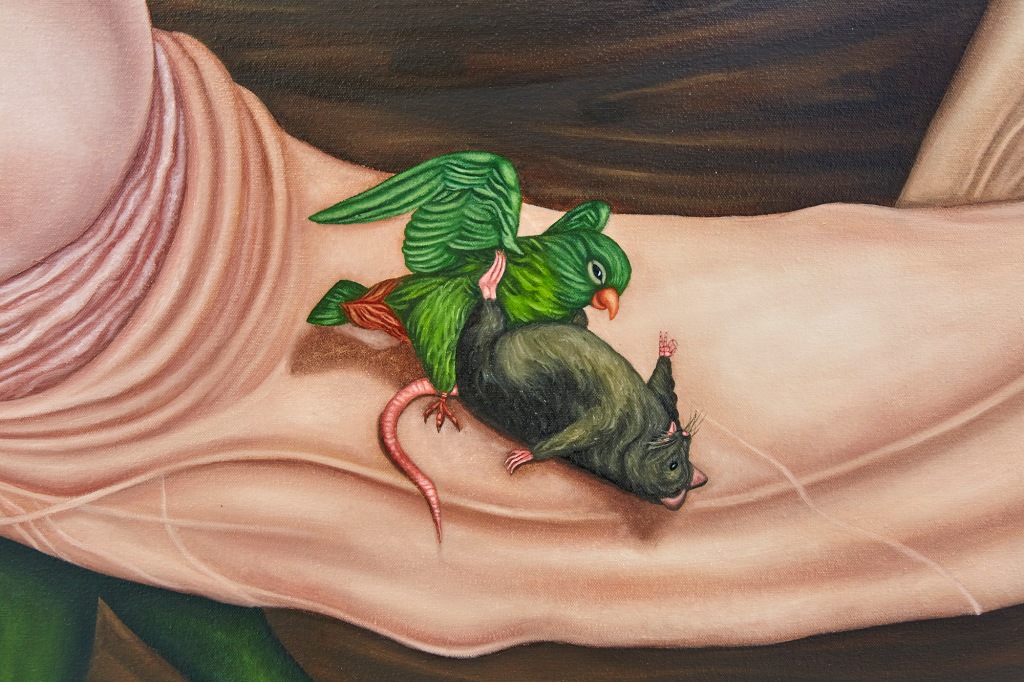
Glen Pudvine, ‘Dawn‘, oil on canvas, framed, 186 x 166cm. Courtesy of the artist and Lychee One. Photo: Corey Bartle Sanderson.
Marcelle Joseph: Pudvine’s work is more about existential dread and masculine vulnerability than sexuality. In my view, the artist sees himself in both depictions in this work – the naked (not nude) self-portrait whose penis is being pumped up by the neighbouring dinosaur and the salivating dinosaur, complete with sagging breasts and oversized pectorals. This mash-up of gender signifiers intrigues me and exemplifies the multifariousness of masculinity, even among straight white males. As Pudvine says, ‘I don’t know where my vulnerability ends, and my performance begins. What is actually being revealed about being a man, a human or a painter is a question I keep asking myself’.
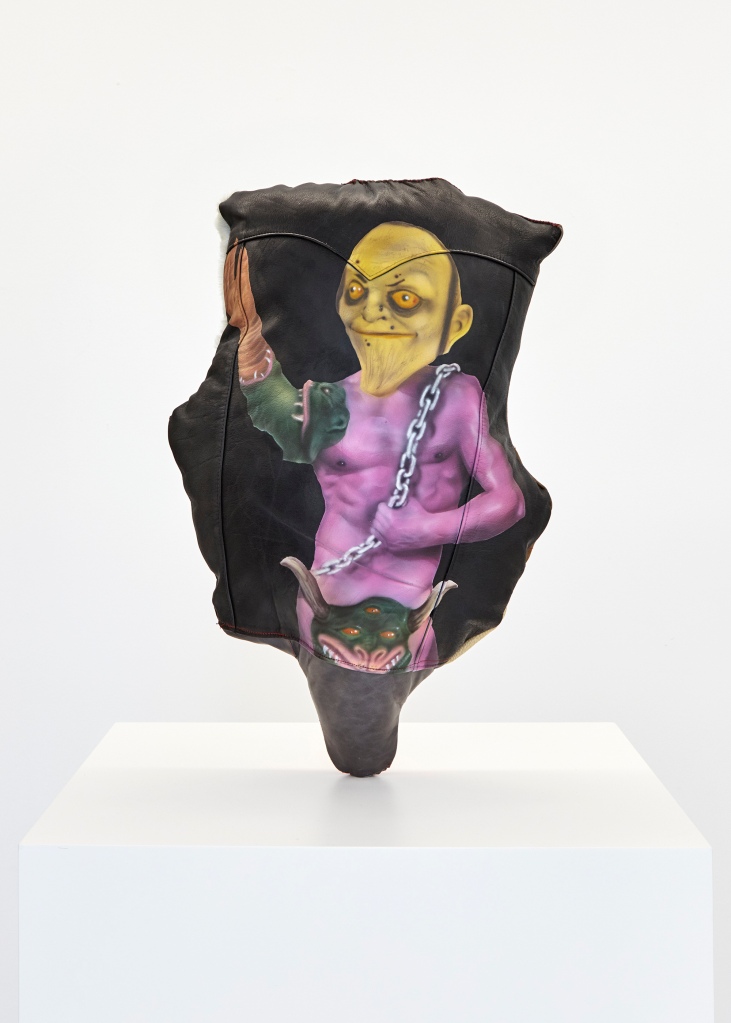
Gray Wielebinski, ‘Chop Shop‘, 2019, custom airbrushed motorcycle vest, hand and
machine sewn leather, denim, jersey, plastic, 60 x 80cm. Courtesy of the artist and Lychee One. Photo: Corey Bartle Sanderson.
Francesco Ferranti: London-based American artist Gray Wielebinski’s ‘Chop Shop’ (2019) offers a precious insight into the artist’s own trans body through repurposing elements from ‘camp’ textiles and Americana- fur, snakeskin, bandanas, Texan cowboy boots, baseball memorabilia. To what extent Wielebinksi’s work intersect gender with structures of power and identity?
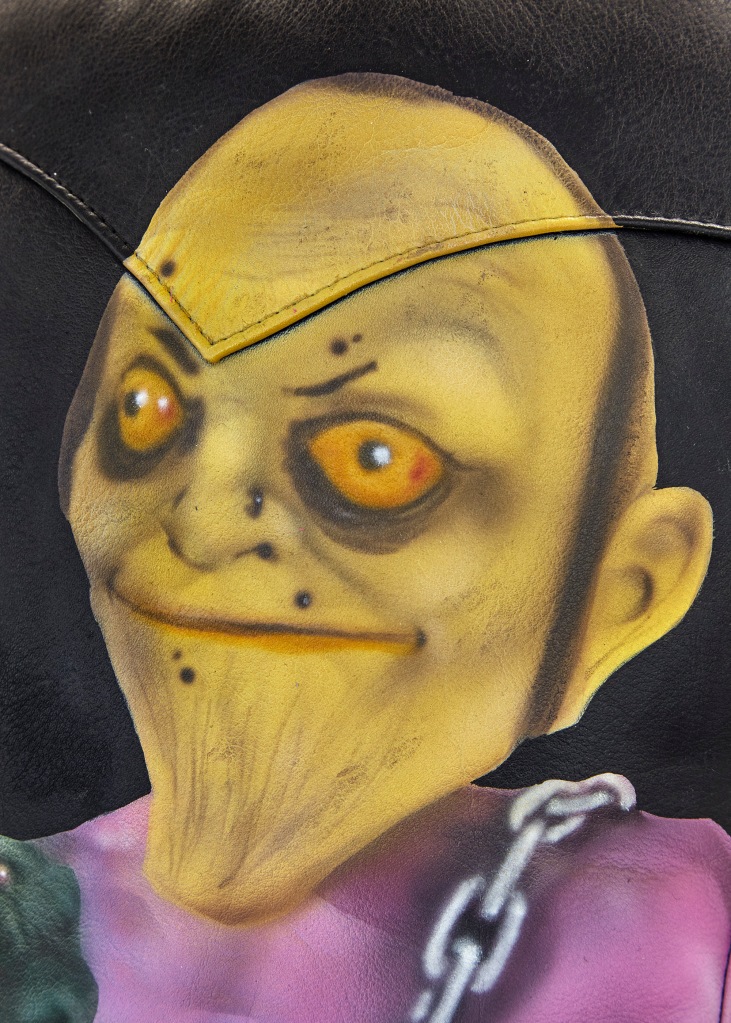
Gray Wielebinski, ‘Chop Shop‘, 2019, custom airbrushed motorcycle vest, hand and
machine sewn leather, denim, jersey, plastic, 60 x 80cm. Courtesy of the artist and Lychee One. Photo: Corey Bartle Sanderson.
Marcelle Joseph: Wielebinski’s work explores trans selfhood through the critique of the all-powerful gaze of the cis-gendered viewer. By creating fantastic and monstrous creatures as stand-ins for their own trans body, Wielebinski questions society’s fixation on the hyper-masculine body and reimagines the body in a non-anthropocentric way that highlights their own ambivalent relationship to masculinity.
Francesco Ferranti: To conclude, can you name some recent examples of queer exhibitions that inspired you?
Marcelle Joseph: I was very inspired by ‘Kiss My Genders’, the recent group exhibition at the Hayward Gallery, in particular, the video installations by Victoria Sin, Hannah Quinlan and Rosie Hastings and Jenkin van Zyl – all outstanding young artists from the queer community that are blazing new trails and flaunting new artistic voices that empower their respective communities.
This may be biased as I supported this exhibition, but I very much enjoyed the ‘Queer Spaces: London, 1980s – Today’ exhibition at the Whitechapel Gallery’s Archive Gallery earlier this year. This was a vital show highlighting this period of crisis for LGBTQ+ venues where gentrification (i.e., capitalist-led redevelopment) has been threatening these safe spaces and social networks for London’s LGBTQ+ communities since the 1980s. At the same time, the exhibition was a wondrous celebration of queer culture.
‘Young Monsters‘ is running at Lychee One, E8 3QA until 26 Oct 2019. For more info about events and upcoming exhibitions, visit the website or Marcelle Joseph’s website and Instagram.



